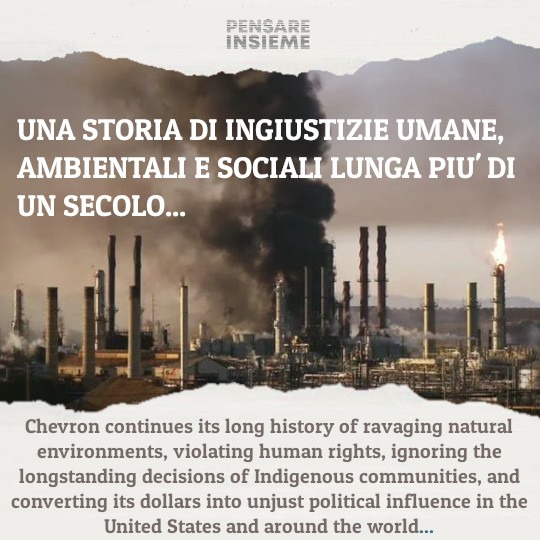Di Dylan De Prosperis – 12/05/2024
The historiography of environmental pollution in the city of Richmond, California, is surprisingly thin, even though toxic contamination in this area persists since the dawn of the 20th century. The scientific articles evaluating externalities caused by polluting industries are few and biased, leading to believe that either researchers lack financial means to carry out rigorous studies, or major discoveries are prevented from being released. Nevertheless, the city of Richmond has undergone an industrialization process which is hard to ignore. Over the past 150 years, the city’s transformation has undoubtedly caused, and keeps perpetuating environmental and social damages.
Present day Richmond was inhabited by the Ohlone indigenous populations for more than 3,000 years until the 1850s, and used to be extremely prolific in natural resources. The vast majority of Richmond’s environmental capital was damaged by the construction of major railroad tracks, which were first built in 1885 and transformed Richmond into California’s major transcontinental railroad site. Richmond’s industrialization process only intensified since then, and was solidified by the arrival of major industrial companies at the turn of the century. Among the largest and most politically influential, the Steel Company of California, American Radiator, Stauffer Chemical and the Giant Powder Company could hardly go unnoticed. The single largest catalyst of population and economic growth, however, has been the 1905 establishment of Standard Oil under president Rockerfeller. Later disguised as Chevron, the Oil Standard transformed this rural town of a couple hundred residents, into the hundreds of thousands strong “Pittsburgh of the West,” home of one of the largest oil refineries in the United States.

Aerial view of Richmond’s Chevron oil refinery complex, overlooking the San Pablo Bay
https://richmond.chevron.com/our-businesses/the-refining-process
The arrival of Big Oil to Richmond in 1902 increased the city’s economic activity at unprecedented rates, however, it caused irreversible social and environmental damages. The invasive development activities required for the construction of the refinery plants, the outdated processes adopted to refine crude oil, and the lack of rigorous waste management treatment systems are only a few of the pollution drivers in Richmond, and several studies specifically tie them to the activities of the Chevron oil refinery. Over the past century, Chevron has been involved with numerous litigation issues concerning violations of labor rights, environmental externalities and negative health effects. Today, Richmond’s economy is still heavily dependent on the tax revenue and jobs generated by the Chevron refinery, at the expense of surrounding natural ecosystems and thousands of families affected by the company’s malpractices and mishandling of pollutants.
Steve Early, lawyer, union representative, and author of “Refinery Town: Big Oil, Big Money and the Remaking of an American City” depicts the characterizing events of Richmond’s recent history, and provides a clear framework to evaluate the environmental and societal footprint left behind by the Chevron refinery. As he narrates, Richmond and its residents had to resist decades of unchecked crime, environmental pollution and health distress due to lack of Chevron’s preventative maintenance. He notes that only in the 1990’s, more than 300 accidents were reported in the Chevron refinery, including “…fires, spills, leaks, explosions, toxic gas releases, flaring and air contamination…” (pp. 30).

Fire at an oil refinery in Richmond, California.
Stock Footage Video ID: 2644469 – www.Shutterstock.com
In recent decades, accidents at Chevron’s refinery increased in intensity and frequency, with Level-3 (most dangerous) explosions and fires happening in 1989, 1999, 2007, 2012, 2014, 2016, 2019, 2020 and 2023.

Fire at the Chevron Refinery in Richmond as seen from Tiburon, California.
Monday August 6th, 2012. John Storey/Special to the Chronicle
https://www.sfgate.com/bayarea/article/Fire-at-Chevron-refinery-in-Richmond-3767221.php
One of Early’s interviewees stated that following the accidents, “…hundreds of people flooded local hospitals complaining of breathing difficulties and vomiting” (pp. 31). Fortunately for Chevron, the company successfully settled tens of litigation cases by paying a few million dollars for failing to provide adequate equipment to employees, as well as reparation of medical expenses of families directly affected by the fumes, ashes and chemicals that creeped into homes, including carcinogens like benzene and asbestos. Hundreds of settlements were also reached to cover up the release of record level amounts of toxic emissions and wastewater pollutants in the surrounding ecosystems (including the bypassing of the wastewater treatment and dumping directly into the San Pablo Bay). However, all of Chevron’s fines and settlement amounts combined barely make up 1% of the company’s revenue, which surpasses $200 billion per year. As put by the author “financial penalties equaled five minutes’ worth of the company’s total operating revenue…” (pp.32-34). Early emphasizes how Chevron owners and managers did not limit themselves to intensifying production activities after the accidents, rather, they hired communication and media specialists to distort the narratives of mayoral candidates which were threatening the existence of the Chevron business. After the 2012 fire explosion, Gayle McLaughlin became the first mayor able to interrupt this vicious cycle of political corruption and perpetual intoxication of Richmond’s environment and residents. Her sustainability oriented leadership led to greater regulation and limits on the expansion of Chevron’s refinery in the city.
Luckily for the residents of Richmond, the authors of “Results of Three Years of Ambient Air Monitoring near a Petroleum Refinery in Richmond, California, USA,” reassure of the non-hazardous nature of the released chemicals. It is one of the few scientific researches conducted to monitor the air quality in the neighborhoods surrounding the Chevron refinery. The authors Sanchez, Saffari, Barczyk, Coleman, Naufal, Rabideau and Pacsi, have concluded that concentrations of critical air pollutants were “…generally below established acute and chronic regulatory thresholds.” In addition, the authors claim that air quality was statistically less polluting than other parts of the same county, and that the major pollutants in the neighborhoods near the Chevron refinery can be attributed to motor vehicle traffic induced pollutants. Essentially, the authors reassure that it is unlikely that pollution levels are not critical, and are not driven by the activities of the refinery operations. Unsurprisingly, each one of the seven authors in the study is employed at Chevron Energy Technology, and acknowledges the support received from Chevron’s refinery in drafting the article. The authors also acknowledge that all funding for the purpose of the study was provided by the refinery itself. Clearly, the results of the study are at no risk of bias.
On a different note, the article “Summary of Chevron in Richmond: Community-Based Strategies for Climate Justice” attempts to alert city residents of the critically dangerous conditions they are facing. As the authors state, the refinery has been on the Environmental Protection Agency watch list, as it violated air compliance standards (High Priority Violation is the highest level for the EPA). In 2007, the EPA reported that the refinery alone was responsible for releasing more than 900,000 pounds of toxic waste annually, and that more than 17 thousand people were directly exposed and affected by those pollutants, as they lived in a three mile radius from the refinery. According to their study, Richmond residents show the highest levels of respiratory issues in the entire Contra Costa County. A staggering 46% of adults and 17% of children living in Richmond suffer from asthma.
In the article “The True Cost of Chevron” the authors reveal how “Chevron continues its long history of ravaging natural environments, violating human rights, ignoring the longstanding decisions of Indigenous communities, and converting its dollars into unjust political influence in the United States and around the world.” The article dives into the unprecedented victory for the community of Richmond in 2010 under McLaughlin’s campaign, when the State Court of Appeals deemed Chevron’s Environmental Impact Report for the expansion of Richmond’s refinery to be violating state environmental laws. In particular, they emphasized how negative health effects are plaguing predominantly low-income neighborhoods, with very strong correlation to locations hit by prevailing winds. The combination of these factors has mobilitated several environmental justice movements, and led to significant progress in the electoral process for mayoral candidates of Richmond. However, as of recent years, Chevron’s Richmond refinery remains the single largest stationary emitter of greenhouse gas (GHGs) in the state of California and continues to release more than 4.5 million metric tons of CO2 (2009).
As if external air pollution was not enough, a 2008 Brown University toxics exposure study concluded that the air inside Richmond homes is more toxic than outside air, due to harmful pollutants from the refinery being trapped indoors. Indoor levels of particulate matter in Richmond homes were found to be the main cause of respiratory diseases linked to premature death, and confirmed to come from oil refining processes. Concerning levels of other oil refinery related chemicals, including sulfates and vanadium, a heavy metal known to cause cancer and respiratory problems, were found in Richmond homes. As a tragic confirmation, the study points out that Richmond had the third highest number of deaths from cancer between 2003 and 2007 of any city in Contra Costa County.
In the book “Climate Change from the Streets: How Conflict and Collaboration Strengthen the Environmental Justice Movement,” the author Micheal Mendez adds another layer of complexity to Richmond’s environmental and social distress. In the chapter Climate Embodiment, the author explains how children growing up next to the refinery often reported problems such as asthma, headaches, and other ailments. According to long-term Richmond resident Sandy Saeteurn, “There were incidents at the refinery when I was little, when they would have a spill. . . I would get so sick that I would have to go to the hospital. My eyes swelled almost closed, and my body would be covered in hives.” The author claims that environmental regulations in these communities are poorly enforced and violations of air quality rules are very frequent. Over a 10-year period, 13 violations were recorded per every 100,000 people, compared with 0.96 for the entire San Francisco Bay Area. As quoted in the book, environmental justice groups argue that refinery pollution not only fuels climate change but also contributes to high rates of asthma, cancer, and heart disease. According to the California Department of Public Health, Richmond residents of all ages are almost twice as likely to go to hospital emergency rooms for asthma attacks as others living in the region. African Americans in the area, in particular, have the highest rate of asthma emergency visits and admissions in the county, four times higher than other racial groups. Confirming this trend of environmental injustice, a 2018 study conducted by Lara Cushing found that California facilities emitting the highest levels of both greenhouse gases and particulate matter tend to be located in neighborhoods with higher proportions of residents of color. Other studies recognize this pattern on a wider range of co-pollutants, including particulate matter, nitrogen oxides, and sulfur dioxide. Unsurprisingly, Richmond’s Chevron refinery is a leading emitter of those chemicals.
In Richmond, environmental justice advocates ask how residents deal with the cumulative impact of pollution from industrial facilities. While the Chevron refinery is the state’s largest greenhouse gas polluter, people in Richmond also live near four other oil refineries, three chemical companies, eight federally designated Superfund sites, and dozens of other toxic waste sites. In particular, they contend that years of exposure to toxic air emissions and lung-penetrating particulate matter from industries, truck routes, and rail lines adjacent to neighborhoods may also be affecting residents. However, the consequences of these interconnected conditions have not been well studied yet. Epidemiologists often find it challenging to prove a direct correlation between exposures and disease because of confounding factors such as smoking and diet. Conventional health studies have been unable to fully determine why the asthma rate is so elevated in Richmond, but we can build on the existing research to trace environmental distress back to Big Oil.
BIBLIOGRAPHY
[1]. Choy, Ellen, and Ana Orozco. “Chevron in Richmond: Community-Based Strategies for Climate Justice.” Race, Poverty & the Environment 16, 43–46. 2009.
[2]. Antonia Juhasz. “The True Cost of Chevron an Alternative Annual Report.” 2011. https://truecostofchevron.com/2011-alternative-annual-report.pdf.
[3]. Cohen, Alison, Andrea Lopez, Nile Malloy, and Rachel Morello-Frosch. “Our Environment, Our Health: A Community-Based Participatory Environmental Health Survey in Richmond, California.” Health Education & Behavior 39. 2012.
[4]. Chevron Richmond Refinery Crude Unit Incident. Loss Prevention Bulletin, no. 234. 2012.
[5]. Gonzales, Daniel, et al. Cost-Benefit Analysis of Proposed California Oil and Gas Refinery Regulations. 2016.
[6]. Early, Steve. Refinery Town: Big Oil, Big Money, and the Remaking of a American City. Boston, Beacon, 2018.
[7]. Fortson, Alistair W. “Victory Abroad, Disaster at Home: Environment, Race, and World War II Shipyard Production.” California History 94 : 20–36. 2017.
[8]. Sanchez, Nancy P., et al. “Results of Three Years of Ambient Air Monitoring near a Petroleum Refinery in Richmond, California, USA.” Atmosphere, 2019. Vol. 10, no. 7, 11 p. 385, https://doi.org/10.3390/atmos10070385.
[9]. Méndez, Michael. Climate Change from the Streets: How Conflict and Collaboration Strengthen the Environmental Justice Movement. JSTOR. Yale University Press. 2020.

Studente del Master of Real Estate Development a UC Barkeley, promessa del golf e socio osservatore di Pensare Insieme



 Siciliano di nascita, calabrese per motivi di studio e romano per motivi di lavoro, dopo la laurea in Ingegneria delle Tecnologie Industriali indirizzo Economico Organizzativo nel lontano 1981 e uno stage su attività riguardanti la pianificazione, programmazione e controllo della produzione presso la Nuova IB-Mei di Asti, ho lavorato per diversi anni nei vari stabilimenti della Selenia Industrie Elettroniche Associate S.p.A. di Roma come analista di organizzazione.
Siciliano di nascita, calabrese per motivi di studio e romano per motivi di lavoro, dopo la laurea in Ingegneria delle Tecnologie Industriali indirizzo Economico Organizzativo nel lontano 1981 e uno stage su attività riguardanti la pianificazione, programmazione e controllo della produzione presso la Nuova IB-Mei di Asti, ho lavorato per diversi anni nei vari stabilimenti della Selenia Industrie Elettroniche Associate S.p.A. di Roma come analista di organizzazione.
 “Se vuoi aver successo nella vita, fai della perseveranza il tuo migliore amico, dell’esperienza il tuo saggio consigliere, della cautela il tuo fratello maggiore e della speranza il tuo angelo custode” – Joseph Addison …e la mia vita è stata finora sicuramente colorata da una moltitudine di caute perseveranti esperienze.
“Se vuoi aver successo nella vita, fai della perseveranza il tuo migliore amico, dell’esperienza il tuo saggio consigliere, della cautela il tuo fratello maggiore e della speranza il tuo angelo custode” – Joseph Addison …e la mia vita è stata finora sicuramente colorata da una moltitudine di caute perseveranti esperienze.



 Nata a Napoli nel 1967, psicologa dell’arte e artista sperimentale.
Nata a Napoli nel 1967, psicologa dell’arte e artista sperimentale. Studi classici, poi Ingegnere chimico dal 1982.
Studi classici, poi Ingegnere chimico dal 1982. Nato a Napoli nel 1974. Dopo il diploma di maturità scientifica, ho conseguito la laurea in Economia e Commercio presso l’Università degli Studi Federico II di Napoli ed un Master post-laurea in E-business presso l’ordine dei dottori commercialisti di Napoli.
Nato a Napoli nel 1974. Dopo il diploma di maturità scientifica, ho conseguito la laurea in Economia e Commercio presso l’Università degli Studi Federico II di Napoli ed un Master post-laurea in E-business presso l’ordine dei dottori commercialisti di Napoli. Inguaribile sognatrice! Mi piace definirmi semplicemente una persona, che ogni giorno si sveglia e affronta la realtà e le mille sfide della vita, un CUORE che crede nel prossimo e che vorrebbe vivere e lottare, per regalare sorrisi, gioia e speranza, un aiuto fattivo a chi non può ma vorrebbe, a chi non sa che potrebbe, a chi ha una coscienza viva solo bisognosa di essere risvegliata.
Inguaribile sognatrice! Mi piace definirmi semplicemente una persona, che ogni giorno si sveglia e affronta la realtà e le mille sfide della vita, un CUORE che crede nel prossimo e che vorrebbe vivere e lottare, per regalare sorrisi, gioia e speranza, un aiuto fattivo a chi non può ma vorrebbe, a chi non sa che potrebbe, a chi ha una coscienza viva solo bisognosa di essere risvegliata. Nato sul finire del 1964, frequento gli studi classici ed interrompo la mia formazione durante il secondo anno di Scienze Politiche.
Nato sul finire del 1964, frequento gli studi classici ed interrompo la mia formazione durante il secondo anno di Scienze Politiche. Classe 1984. Ho frequentato l’Istituto Tecnico per il Turismo.
Classe 1984. Ho frequentato l’Istituto Tecnico per il Turismo. Nato a Benevento nel 1975, nel luglio del 1994 conseguo il diploma di maturità Tecnica Industriale e nel 1995 mi iscrivo al corso di laurea in ingegneria informatica, corso che sospendo dopo il biennio di esami generali per passare alla vita lavorativa.
Nato a Benevento nel 1975, nel luglio del 1994 conseguo il diploma di maturità Tecnica Industriale e nel 1995 mi iscrivo al corso di laurea in ingegneria informatica, corso che sospendo dopo il biennio di esami generali per passare alla vita lavorativa. Nata a Lingua, frazione del comune Santa Marina Salina (Isole Eolie) il 02/12/1953
Nata a Lingua, frazione del comune Santa Marina Salina (Isole Eolie) il 02/12/1953 Ex presidente Lega Missionaria Studenti, ex diplomata in Scenografia & Costume accademia di Belle Arti – Roma, ex indossatrice, ex Presidente sindacato italiano indossatori/indossatrici, ex soubrette, ex fashion designer, ex educatore TRAGER (integrazione psico- fisica), ex moglie, ex Movimento 2050.
Ex presidente Lega Missionaria Studenti, ex diplomata in Scenografia & Costume accademia di Belle Arti – Roma, ex indossatrice, ex Presidente sindacato italiano indossatori/indossatrici, ex soubrette, ex fashion designer, ex educatore TRAGER (integrazione psico- fisica), ex moglie, ex Movimento 2050. Marchigiano di origine, cittadino del mondo. Laurea in Economia presso Univpm, ex ufficiale di complemento, opera nel marketing e nelle vendite in Italia, Regno Unito e Stati Uniti, con ramificati contatti ed interessi in vari paesi di più continenti.
Marchigiano di origine, cittadino del mondo. Laurea in Economia presso Univpm, ex ufficiale di complemento, opera nel marketing e nelle vendite in Italia, Regno Unito e Stati Uniti, con ramificati contatti ed interessi in vari paesi di più continenti.